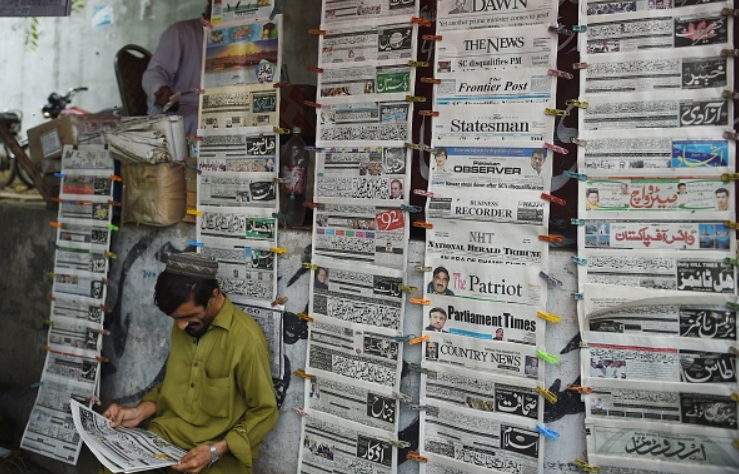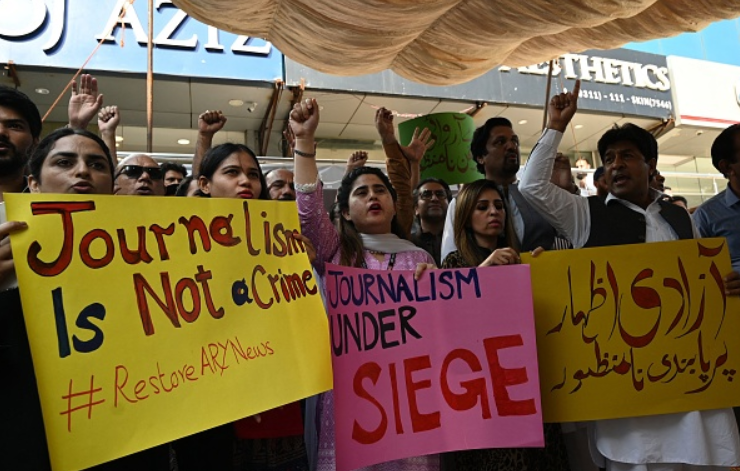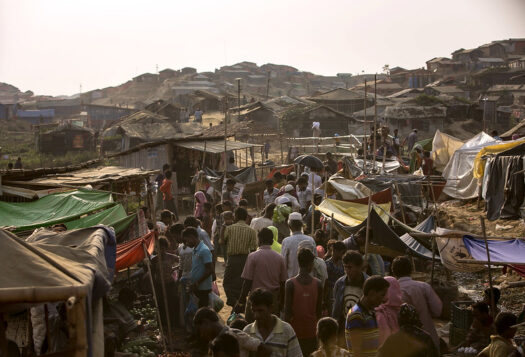
Last month, Pakistani police charged former Prime Minister Imran Khan under the anti-terrorism act, in addition to placing a sweeping ban on live telecasts of his speeches. The charge comes after Khan vowed to sue police officers and a judge over the alleged torture Shehbaz Gill, his close aide, who is in police custody on sedition charges. However, as the current administration looks to stamp out Imran Khan’s continued street power, media freedom appears to be the primary casualty.
Over the past two decades, Pakistan has produced a relatively vibrant media sector that represents a diversity of political views and opinions. However, in recent years, subsequent governments and the military establishment alike have curtailed media freedom in ways that threaten pluralism and journalistic independence in the country. This has been done by drawing new “red lines” against unpalatable issues. Previously, this practice of silencing the media was limited mostly to the peripheries of the country. The case of the Pashtun Tahafuz Movement (PTM) is perhaps the most notable, where reporters have been told to “lie low” in their reporting to not contradict the official narrative. However, the latest trends in curtailing media freedom have been increasingly concentrated in major cities, becoming more set under Pakistan Muslim League-Nawaz (PML-N) party from 2013 to 2018 and Pakistan Tehreek-e-Insaf (PTI) from 2018 to 2022.
With the growing polarization of both domestic politics and the media space in Pakistan, the arbitrary and political use of power by successive governments to stifle political dissent and weaken the opposition has come at a greater cost to media freedom and democracy in the country. With each party in power seeking to benefit from media restrictions, this trend shows little signs of change.
Track Record of Media Freedom under PML-N and PTI
In the past decade, limiting the press has been done using different means including new legal mechanisms, physical coercion, violence against journalists, and media blackouts. While politicians may promise to improve press freedoms out of office, the press environment has continued to weaken over successive administrations. For instance, the PML-N promised to enact a journalists’ protection law in its 2013 election manifesto but this remained on hold throughout its tenure until 2018. Instead, in 2016, Pakistan’s National Assembly approved the Prevention of Electronic Crimes Bill (2015), which allowed for “sweeping censorship of the internet” and was criticized especially for giving substantial power and discretion to enforcement agencies. That same year, Pakistan was ranked among the 10 worst countries for internet freedom and fourth among the 10 worst countries for journalists. 157 attacks on journalists were reported between May 2017 and April 2018 during the last years of the PML-N tenure. Earlier, there were also armed attacks on senior journalists Hamid Mir in 2014 and Cyril Almeida in 2016. Almeida was “barred from leaving the country” following his report on a civil-military row in what famously became known as the “Dawn Leaks.”
With the growing polarization of both domestic politics and the media space in Pakistan, the arbitrary and political use of power by successive governments to stifle political dissent and weaken the opposition has come at a greater cost to media freedom and democracy in the country.
Similarly, despite promises during Imran Khan’s campaign for Prime Minister on greater press freedoms, the PTI government took a different turn once in office. It extended media regulation to digital media and proposed the formation of Pakistan Media Development Authority (PMDA) in May 2021. Rejected across the media industry, the PMDA threatened digital media freedom and public-interest journalism in the country.
The PTI’s rhetoric also set a dangerous framing of the relationship between media and politics. In July 2019, the PTI official Twitter account linked critical media coverage as potential “treason” and Imran Khan later referred to criticisms of the state’s of press freedom in Pakistan as “a joke”. In 2021, Reporters Without Borders (RSF) termed Khan a “predator” under whose government, Pakistan was “reliving some of the worst moments of its past military dictatorship.”
In the last year of the PTI government, Pakistan registered a steep decline of 12 points on the World Press Freedom Index (2022), with at least 86 cases of attacks on media persons between April 2021 and May 2022, with state actors said to be the largest source of threats.
The Still Shrinking Space for Dissent
Like other administrations before it, the PML-N-led coalition government initially promised press reforms and announced its intentions to “disband” the PMDA as Prime Minister Shehbaz Sharif boasted his commitment to “freedom of press and speech.” However, despite these bold promises, press freedom thus far has only appeared to deteriorate further. This time, journalists subscribing to the PTI narrative of “regime change” are at the receiving end of censorship and violence.
Media censorship and stifling dissent, which reached new heights under Imran Khan, have now returned to haunt his supporters after his ouster. On July 5, a prominent pro-PTI journalist Imran Riaz Khan was detained for 17 treason charges. Just a week earlier, Ayaz Mir, a senior journalist, was physically assaulted by “unidentified men” for criticizing the military establishment. This set in motion a series of events where the government has been targeting pro-PTI journalists and media houses. More recently on August 12, the government revoked the operating license of ARY News for broadcasting “seditious content” during an interview with Shehbaz Gill, the PTI’s Chief of Staff, and launched an investigation of ARY CEO Salman Iqbal and other journalists after the controversial remarks. The Pakistan People’s Party (PPP) Senator Farhat Ullah Babar expressed his concern over the lack of due process in action against ARY News, saying that “using state power arbitrarily will backfire.”

For political leadership, legal mechanisms have been a powerful tool to go after dissent but more often, this acts as a smokescreen for the military’s ability to exercise influence. The military establishment has always had a checkered relationship with the fourth estate, and many of the targeted journalists have been critical of the military’s role in politics. Daniel Bastard, the head of RSF’s Asia-Pacific Desk, has argued that despite the change in governments, harassment of journalists keeps on recurring as the military intervenes behind the scenes to “bring Pakistan’s journalists to heel.”
Polarization in Media and Political Loyalties
The scale of domestic polarization has also shaped the press environment as it spreads across media outlets, which can become a megaphone for the powerful elite, the sitting government, or the military establishment.
In a clear display of such polarization in December 2020, the PTI official Twitter handle issued a list of “good” and “bad” journalists. ‘Bad journalists’ belonging mostly to the Jang Group’s Geo TV were targeted for “building narrative for the corrupt”, while ‘good journalists’ belonging mostly to the ARY News were celebrated as “brave & bold” who are “fighting the war of truth & justice.” Similarly in May this year, PML-N President Maryam Nawaz Sharif singled-out ARY News and accused its owner for “smuggling gold”.
This polarization within the media space has also contributed to a lack of collective response from media platforms. This is bolstered by narratives of media being “out of control,” making censorship of a particular media group not a collective threat to freedom of expression but a triumph to celebrate by the rival political and media groups. For instance, the arbitrary exercise of power against pro-PTI journalists today stems from the draconian laws proudly introduced by the previous Khan-led government that has shrunk the space for dissent. Similarly, when politicians restrain media freedom for their own political gains, the beneficiaries are ultimately the anti.-democratic forces.
This polarization within the media space has also contributed to a lack of collective response from media platforms. This is bolstered by narratives of media being “out of control,” making censorship of a particular media group not a collective threat to freedom of expression but a triumph to celebrate by the rival political and media groups.
Targeting and punishing dissenting voices threatens to define Pakistan’s political culture. However, repressing dissenting voices is a self-inflicted wound. It does not make the dissent go away but rather highlights state’s heavy hand threatening to erode the democratic institutions that are essential for the sustainability of the state in the long term.
Therefore, the government in power should avoid making political use of its authority by shrinking the space for dissent as it empowers the anti-democratic forces at the greater expense of freedom of expression. Media too should put the collective threat to journalism in Pakistan above political partisanship to demonstrate and strengthen their essential role in democracy and information sharing. The impacts generated by media censorship will additionally only undermine the transparency of the upcoming 2023 elections, which are already expected to be fraught with challenges including institutional mistrust and fears of rigging. Instead of politicizing it, the incumbent government should promote greater media freedom by repealing laws that restrain press freedom and protect freedom of expression as the inevitable feature of a vibrant democratic future in Pakistan.
***
Image 1: FAROOQ NAEEM/AFP via Getty Images
Image 2: AAMIR QURESHI/AFP via Getty Images


